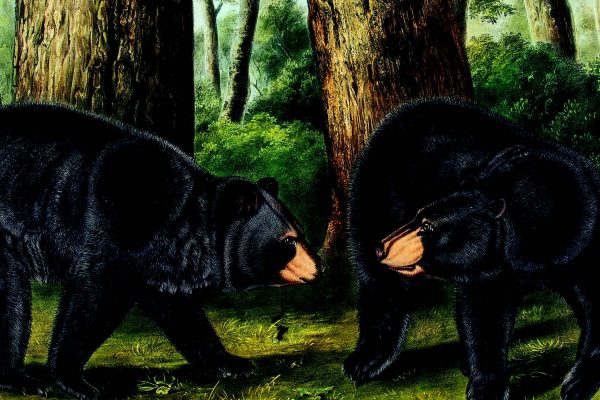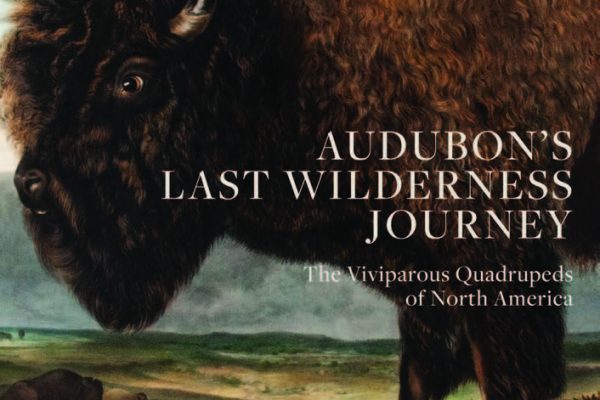Professors from Auburn University’s School of Forestry and Wildlife Sciences recently contributed to the book “Audubon’s Last Wilderness Journey: The Viviparous Quadrupeds of North America,” a reproduction of John James Audubon’s last great natural history work.
The book features a reproduction of all 150 original, hand-colored lithographic prints from Audubon’s color plate book “Viviparous Quadrupeds of North America” which was published in 1849. It also includes a timeline of Audubon’s life and career, a map of his 1843 expedition into the pre-settlement wilderness and essays by noted experts in the fields of art history, conservation and life science.
“Audubon’s Last Wilderness Journey” was debuted at Auburn University’s Jule Collins Smith Museum of Fine Art during the ‘Launch and Learn’ event, during which the contributing authors of the book were present to showcase their research and share their perspectives on the project. To accompany the book launch, the museum exhibited the complete collection of artwork from Audubon’s “The Viviparous Quadrupeds of North America,” which was published in three volumes between 1845 and 1848.
“The book is a great way to make these prints available to the public while providing updated information about the animals,” said School of Forestry and Wildlife Sciences Professor and Extension Specialist James Armstrong, one of the contributing authors of “Audubon’s Last Wilderness Journey.” Armstrong’s role in the book was to describe human and wildlife interactions and how the populations of the various mammals presented in in the book have fluctuated since the 19th Century.
Armstrong said many of the mammals Audubon portrays in “Viviparous Quadrupeds of North America,” particularly coyotes, deer and beavers, have had to adapt to changing landscapes in North America since Audubon’s time and are now found not just in rural areas, but also in cities.
These changes in the animals’ habitats have caused their populations to fluctuate over the past 150 years. “Our actions need to be carefully planned for the positive and negative effects they will have on our wildlife resources,” Armstrong said in “Audubon’s Last Wilderness Journey.”
Robert Gitzen, an assistant professor with the School of Forestry and Wildlife Sciences, contributed to “Audubon’s Last Wilderness Journey” by assessing how Audubon’s prints have value as sources of scientific information as well as being valuable artistic pieces.
“John James Audubon’s paintings and prints remain uniquely relevant to both art and science because of his interweaving of skills and passions as a naturalist and artist,” Gitzen said.
In addition, Gitzen said that not only do the paintings provide the public with realistic portrayals of the animals, but they also provide scientists with valuable information. “What is exciting is Audubon and Bachman introduced multiple species to science through their original text and Audubon’s illustrations, such as the black-footed ferret, which over the last several decades has had one of the highest profile conservation success stories of any species in North America,” stated Gitzen.
School of Forestry and Wildlife Sciences Professor Christopher Lepczyk wrote an essay for “Audubon’s Last Wilderness Journey” that highlights how society’s view of wildlife has changed since the original publication of “Viviparous Quadrupeds of North America.”
Lepczyk said that society now views nature and wildlife with a much greater ecological understanding as opposed to the 19th century, when most people believed there was an endless abundance of animal species, which led to overhunting of many mammals.
Another contributing author, Associate Professor of Disease Ecology Sarah Zohdy, wrote a section of the book highlighting the modernization of natural science and how the field of study has changed over the past 200 years.
Zohdy said she hopes readers of “Audubon’s Last Wilderness Journey” will have a greater appreciation for both art history and science. “I would like the readers to see the images, and really appreciate that many of the illustrations were the first descriptions of those species and often were the first introduction of those animals to the general public.”
In accompaniment to the book launch, National Geographic photographer Joel Sartore visited Auburn University to discuss issues affecting wildlife and their habitats. Similarly to Audubon, Sartore’s mission is to capture images of the world’s rarest animals before they disappear. He has done so by creating the National Geographic Photo Ark, his collection of nearly 8,000 images of species he has photographed.
Zohdy said Sartore’s Photo Ark is a perfect example of how capturing images of wildlife has evolved since Audubon’s book was first published. “Joel Sartore is truly a modern-day Audubon,” she said.
Recently “Audubon’s Last Wilderness Journey” was featured in the prestigious scientific journal, Nature, which listed the book as one of the best science publications of this year. Lepczyk’s chapter titled, “The Shifting Views of Nature and Wildlife,” was also reprinted in the March issue of Natural History.
“Audubon’s Last Wilderness Journey” was published by the Jule Collins Smith Museum of Fine Art, Auburn University and D Giles LTD of London and is available for sale online via Amazon.com.
Originally published in the SFWS Summer 2018 Newsletter.
(Written by Jamie Anderson)













